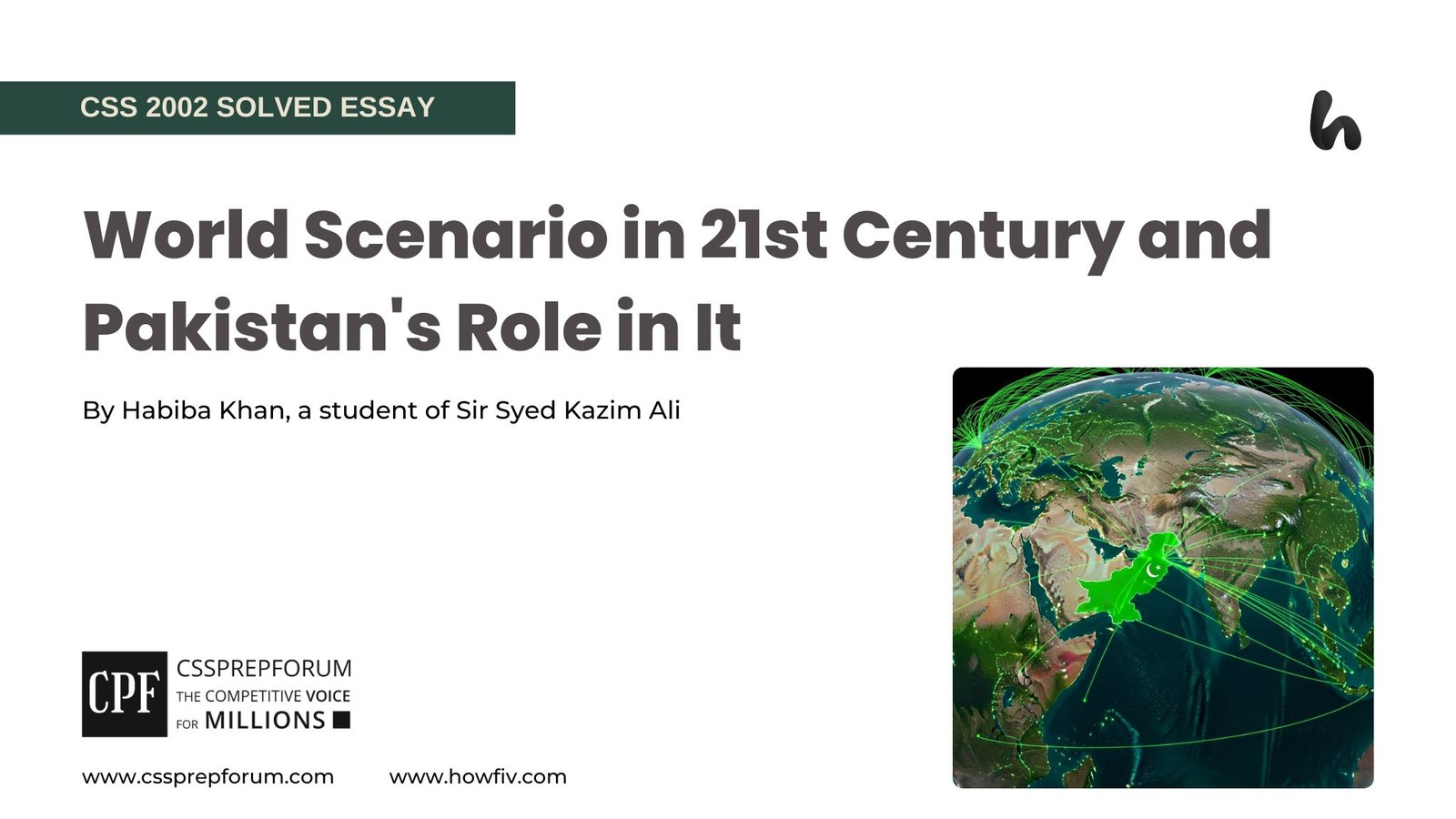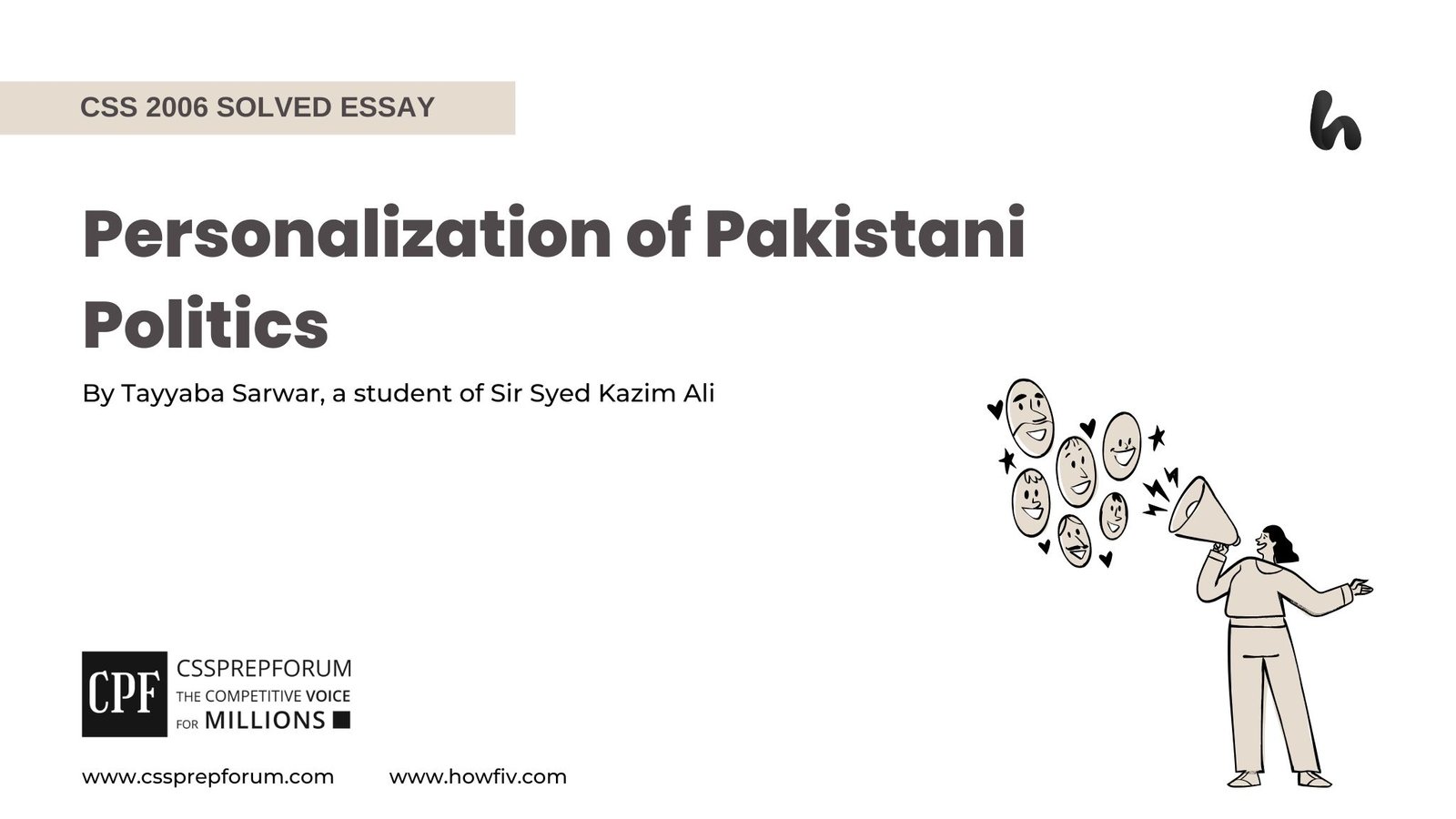CSS Current Affairs | Practical Model to Overcome Pakistan’s Energy Issues
The following question of CSS Current Affairs is solved by Mubasit Naeem under the supervision of Howfiv’s Pakistan Affairs and Current Affairs Coaches. She learnt how to attempt 20 marks question and essay writing from Sir Syed Kazim Ali, Pakistan’s best CSS and PMS English essay and precis teacher with the highest success rate of his students. This solved past paper question is attempted on the pattern taught by Sir to his students, scoring the highest marks in compulsory and optional subjects for years, and uploaded to help aspirants understand how to crack a topic or question, how to write relevantly, what coherence is, and how to include and connect ideas, opinions, and suggestions to score the maximum.

Outline
1- Introduction
2- A short overview of the energy issues in Pakistan
3- An integrated model that comprises the following sub-parts can make Pakistan overcome the energy issues once or for all
3.1- Renewable energy leadership
- ✓Solar power
- Evidence: According to the Alternative Energy Development Board (AEBD), Pakistan has the potential to generate over 2.9 million megawatts (MW) of electricity from solar energy and nearly 40,000 MW of distributed solar system potential (rooftop solar capacity).
- ✓Wind power
- Case in point: According to the National Renewable Energy Department of the USA, Pakistan has a wind energy potential of approximately 132GW at the Gharo-KetiBandar wind corridor.
- ✓Hydropower
- Evidence: The International Hydropower Association (IHA) 2022 stated that Pakistan has a hydel potential of 41722 MW, most of which lies in Khyber Pakhtunkhwa, Gilgit Baltistan, and Azad Kashmir.
3.2- Energy efficiency improvements
- ✓Energy audits of the industrial sector
- Case in point: According to the Pakistan Institute of Development Economics (PIDE), energy audits can reduce industrial audit consumption by 15-20%.
- ✓Building codes and retrofit programs
- Evidence: Pakistan Green Building Council works on energy-efficient construction standards for buildings, and the National Energy Efficiency and Conservation Authority (NEEC) has been working on retrofitting existing buildings
3.3- Infrastructural modernization
- ✓Installation of the innovative grid system and revamp of the old transmission system
- Case in point: Revamping an outdated transmission system and installing a smart grid system can reduce 19.5% of line losses, as reported by the National Electric Power Regulatory Authority.
- ✓Focus on power storage
- Evidence: The implementation of pumped hydropower storage systems and lithium-ion batteries at large scale to enhance power backup, as the USA has 22GW and the UK has 200MW pumped hydropower storage systems, reported by the Office of Energy Efficiency and Renewable Energy.
3.4- Capacity building and awareness, along with stable policies
- ✓Technical training programs and public awareness campaigns
- ✓Long-term vision.
3.5- Negotiation with existing independent power producer (IPPS)
- ✓South African negotiation with IPPs.
3.6- Timely completion of existing and ongoing projects
- ✓CASA1000
- ✓TAPI and IP pipeline projects
4- Conclusion

Answer to the Question
Introduction:
In the modern world, energy measures a country’s prosperity and development. The more energy-sufficient a country is, the more it is ready to shine among the constellations of countries, and vice versa. Pakistan, a country in South Asia, faces numerous challenges in its energy sector, including frequent power outages, an overreliance on imported fuels, inefficient energy use, outdated infrastructure, and a vicious cycle of circular debt. These issues have impeded economic growth and aggravated social unrest among the masses. Moreover, population bulges that result in scarcity of natural resources have continued to outstrip energy demand, leading to severe load shedding, particularly during peak season (summer). Addressing these challenges requires a comprehensive and practical model that ensures energy security and solutions to existing energy crises. An integrated energy model encompassing renewable energy development, energy efficiency improvement, infrastructural modernization, and following stable policies along with timely completion of ongoing and existing projects is imperative. Drawing on successful international ventures that are entirely suitable for Pakistan’s unique context, this model can pave the way for a sustainable energy future. This comprehensive model addresses the current energy crisis and sets the foundation for long-term energy security, ultimately bringing economic prosperity to the country.
A short overview of the energy issues in Pakistan:
Pakistan, a country of 242 million people, has been facing an energy crisis of a time high since its inception. This vicious trap pushes its feeble economy to a dead end and fosters social unrest. Chronic power shortages, heavy reliance on imported fuels, outdated infrastructure, inefficient distribution system, short-term policies, IPP manipulation, energy mix dominated by non-renewable resources, circular debt, and no mega project in the last three decades, and inefficient usage of indigenous resources collectively give birth to an unmounted giant of energy crisis in Pakistan.
An integrated model that comprises the following sub-parts can make Pakistan overcome the energy issues once or for all:
An integrated model, widely accepted in the modern world, is a practical example of overcoming Pakistan’s energy issues. It comprises renewable energy leadership, energy efficiency improvement, infrastructural modernization, capacity building with public awareness, the initiation of stable policies, and timely completion of energy-related projects. In Pakistan, negotiation with independent power producers (IPPs) is also a part of the integrated energy model.
1-Renewable energy leadership:
Pakistan produces a major chunk of its energy from non-renewable resources. According to a report published by the Ministry of Finance in 2022, energy produced from non-renewable resources is about 46.2% of total energy, mainly from furnace oil and imported coal. To counter this, a larger share of renewable energy (solar, hydro, and wind power) in the energy mix will help mitigate energy issues as a main part of the integrated energy model.
- Solar power:
In the temperate zone, Pakistan is blessed with the potential for immense utility-scale power projects, particularly in Punjab and Sindh. Along with utility-scale power projects, distributed solar systems, largely rooftop solar installations, are also a good source of harnessing the solar potential of this particular country, Pakistan. According to the Alternative Energy Development Board (AEBD), Pakistan has the potential to generate over 2.9 million megawatts (MW) of solar electricity along with nearly 40,000 MW of distributed solar system potential (rooftop solar capacity). For instance, the Quaid-e-Azam Solar Power plant in Bahawalpur is a pilot project for this initiative.
- Wind power:
Wind power comes next to solar power in renewable resources. Nature has gifted Pakistan a wind corridor (Gharo-KetiBandar wind corridor) with a 160km coastal line. According to the National Renewable Energy Department of the USA, Pakistan has a wind energy potential of approximately 132GW at the Gharo-KetiBandar wind corridor. Harnessing this potential can bring significant energy production to lessen dependence on non-renewable resources.
- Hydropower:
Pakistan, along with the humongous potential of wind and solar power, is also blessed with the non-curtailing potential of hydropower. The southern region, especially the upper Indus basin and its tributaries, is the most suitable site for Dams. For instance, International Hydropower Association (IHA) in 2022 stated that Pakistan is endowed with a hydel potential of 41722 MW, most of which lies in Khyber Pakhtunkhwa, Gilgit Baltistan, and Azad Kashmir. This alone can be enough to support Pakistan’s crisis-driven energy sector.
2-Energy efficiency improvements:
After energy production, an integrated model is developed, focusing mainly on energy efficiency improvements. Energy efficiency improvement is divided into two parts. One is energy audits of industrial sectors to mitigate energy consumption, and the other is retrofit programs attached to green building codes.
- Energy audits of the industrial sector:
The industrial sector uses much energy to run the country’s economy. In an era of innovation, energy-efficient equipment and alternative advanced methods are introduced to power industries at low energy usage; consequently, Pakistan has the potential to introduce a modern, conducive industrial plan through an audit of this sector. For instance, according to the Pakistan Institute of Development Economics (PIDE), energy audits can reduce industrial consumption by 15-20%. PIDE shows how crucial it is to adopt modern techniques in the industrial sector.
- Building codes and retrofit programs. “
Energy efficiency improvements are also majorly focused on retrofit programs like promoting LED lights instead of bulbs across the country and introducing green building codes for constructing new ones according to the world standard known as green buildings. For example, the Pakistan Green Building Council (PGBC) works on energy-efficient building construction standards. The National Energy Efficiency and Conservation Authority (NEEC) has been retrofitting existing buildings. Strengthening NEEC and casting more engagement with PGBC fosters more fruitful results in this regard.
3-Infrastructural modernization:
The third pillar that empowers the integrated model is infrastructural modernization. Without modernization in infrastructure, no one can bring change through outdated systems with colossal losses, which block the road to progress.
- Installation of innovative grid system and revamp of old transmission system:
With advancements in scientific research, different materials of low resistivity and efficient equipment, in addition to productive methods, are being introduced worldwide. The intelligent grid system is one of them. It can bring less energy loss at a lower (household distribution) level. In addition, revamping the transmission line can lessen losses at non-significant sight. For Pakistan, a Revamp of the outdated transmission system and an intelligent grid system installation can reduce 19.5% of line losses to 2-3%, as the National Electric Power Regulatory Authority (NEPRA) reported. It is an essential and primary need of time to get out of crisis.
- Focus on power storage:
Power production and sufficient energy do not guarantee a secure future. Power storage and its use, when needed, play an essential role in its production. Global North established many energy storage techniques that will bear fruitful results for Pakistan, too. For instance, the Implementation of pumped hydropower storage systems and lithium-ion batteries at large scale to enhance power backup, as the USA has 22GW and the UK has 200MW pumped hydropower storage systems, reported by the Office of Energy Efficiency and Renewable Energy USA.
4-Capacity building and awareness along with stable policies:
Engaging in practical training programs and public awareness programs can help mitigate energy usage and losses. It fosters stability in the integrated model and results in practical solutions to overcome energy crises. For example, the EU conducted a successful public campaign to address the shortage of energy (Gas), focusing on alternative sources. Special training programs are also initiatives to tackle these kinds of issues in the near future. Additionally, a long-term and stable policy is also a need of time and a part of the integrated model that should be considered a priority.
5-Negotiation with existing independent power producers (IPPs):
Independent power producers (IPPs) have met half of Pakistan’s electricity production through generations. The primary mode of production is thermal, which runs on imported fuels. At that time, different forms of agreement were needed, signed between the government of Pakistan and IPPs. South Africa also faces the same problem in the case of IPPs. Pakistan can follow the South African negotiation model by diverting IPPs towards renewable energy projects and cutting down on non-renewable ones.
6-Timely completion of existing and ongoing projects:
Pakistan, a developing country, needs energy to sustain its energy sector and foster its economy. To meet this demand, the government has signed different projects like CASA1000 (a project to import electricity), the Iran-Pakistan gas pipeline, and the TAPI (Turkmenistan Afghanistan Pakistan India) gas pipeline. Timely completion of projects is essential to sustaining the energy demand of an increasing population and economic development.
Conclusion:
In a nutshell, one practical model known as the Integrated model of energy comprises leadership in renewable energy, infrastructural modernization, capacity building, public awareness, implementation of stable policies, negotiation with IPPs, and timely completion of existing and ongoing projects. It is the best solution to the energy crisis in Pakistan. It also promises energy security, mitigates ongoing crises, and can sow seeds for a prosperous country.

CSS Solved Past Papers’ Essays
Looking for the last ten years of CSS and PMS Solved Essays and want to know how Sir Kazim’s students write and score the highest marks in the essays’ papers? Then, click on the CSS Solved Essays to start reading them.
CSS Solved Essays
CSS Solved General Science & Ability Past Papers
Want to read the last ten years’ General Science & Ability Solved Past Papers to learn how to attempt them and to score high? Let’s click on the link below to read them all freely. All past papers have been solved by Pakistan’s top CSS GSA coach having the highest score of their students.
General Science & Ability Solved Past Papers












